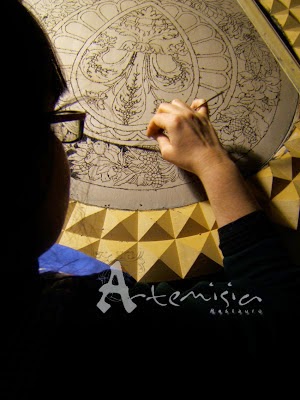What is Graffiti?
After hours of researching the origin of graffiti, I found that according to the Global Brittanica, the word graffiti derives from the Italian word sgraffito.
Because I speak Italian I know that the Global Brittanica gives a bad translation and because I am an artist I know their examples, in part, are lame. Whoever wrote the definition says that in panel painting and illuminated manuscripts the ground was gold leaf. That is not true. For panel painting the ground was, and still is bolo. I'm not sure about illuminated manuscripts but in both cases, sgraffito technique is not involved. The Global Brittanica states that graffito technique was especially used during the middle ages but if you go to Florence or Venice you know that those buildings were decorated during the Renaissance. That's a couple hundred years difference.
So what is Graffiti?
Here is a better definition:
According to the online Italian dictionary Treccani, graffito is a type of decoration used in architecture. The graffer (my word from the commonly used French word graffeur) inscribes the wet stucco of a façade to reveal an under-layer. The technique was (yes) used on medieval palaces but mostly done between 1400 and 1500. In the 1700s there was a revival. Following a design, the graffer removed the top layer of stucco and a exposed the colored underlayer.
Check out Artemesia Restauro's website. This image shows her doing a graffito.
Treccani states:
 |
| Artemesia restauro, Firenze, Italia |
After hours of researching the origin of graffiti, I found that according to the Global Brittanica, the word graffiti derives from the Italian word sgraffito.
Because I speak Italian I know that the Global Brittanica gives a bad translation and because I am an artist I know their examples, in part, are lame. Whoever wrote the definition says that in panel painting and illuminated manuscripts the ground was gold leaf. That is not true. For panel painting the ground was, and still is bolo. I'm not sure about illuminated manuscripts but in both cases, sgraffito technique is not involved. The Global Brittanica states that graffito technique was especially used during the middle ages but if you go to Florence or Venice you know that those buildings were decorated during the Renaissance. That's a couple hundred years difference.
So what is Graffiti?
Here is a better definition:
According to the online Italian dictionary Treccani, graffito is a type of decoration used in architecture. The graffer (my word from the commonly used French word graffeur) inscribes the wet stucco of a façade to reveal an under-layer. The technique was (yes) used on medieval palaces but mostly done between 1400 and 1500. In the 1700s there was a revival. Following a design, the graffer removed the top layer of stucco and a exposed the colored underlayer.
Check out Artemesia Restauro's website. This image shows her doing a graffito.
 |
| Artemesia Restauro, Florence |
Graffito.
Got it?
Treccani states:
- It is a drawing or inscription on a surface or object, more often a wall. In prehistoric times, documents were incised on rocks and clay tablets. It seems banking records were incised on stone, thus the colloquial saying: written in stone.
Paleolithc caves, catacombs, and walls are witness to graffiti.
Cuniform, courtesy of Iranicaonline
 |
| photo courtesy of mesopotamio.co.uk |
 |
| foto courtesy of Giovannidellorto |
Modern day graffiti seems to have all started in the toilet. Here is an excellent article on the Hiphop-Network:
Looking at the Writing on the Wall: A Critical Review and Taxonomy of Graffiti Texts © copyright 1995 Jane M. Gadsby
According to Gadsby's extensive bilbiography, over sixty years ago men and women wrote on bathroom walls. Could this be the beginning of what we consider graffiti in modern times? She writes that "The 1970s were halcyon days of graffiti research".
She writes that there are nine different approaches in graffiti writing. "As expected, each researcher chooses the approach which lends itself to fulfilling his/her needs. This has led to a wide array of approaches: cultural, gendered, linguistic, folkloric, quantitative, aesthetic, motivational, preventative and popularisation
The Treccani dicitonary states that by analogy, graffiti as we know it today, started in NYC in the 1970's. It states also that the film American Graffiti by G. Lucas in 1973, seems to have ignited the explosion. Treccani's definition states that the film refers to the documentary value of prehistoric graffiti, a sign of the past. And it was a revival of taste, fashion, clothing, music of the 1950's.
What is the definition of graffiti today?
Harvard University hosted a reception for the calligraffiti artist el Seed
Listen to what eL Seed says in this video:
No comments:
Post a Comment